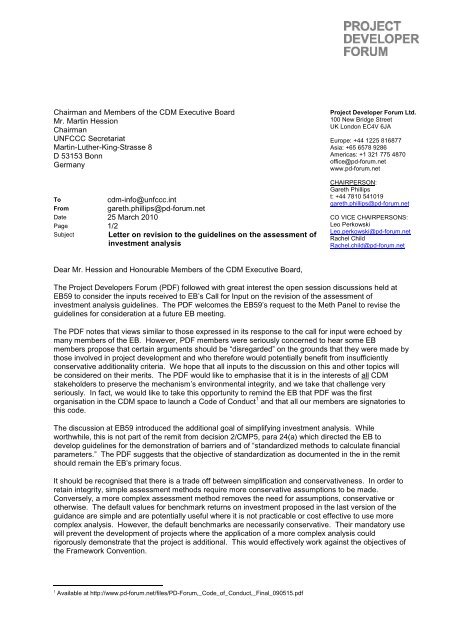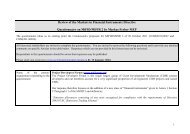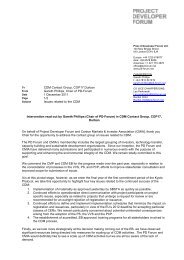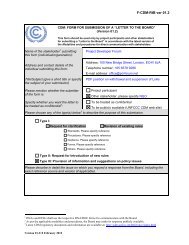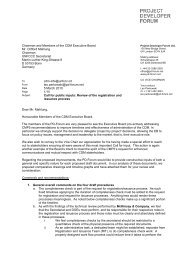Chairman and Members of the CDM Executive Board Mr. Martin Hession ...
Chairman and Members of the CDM Executive Board Mr. Martin Hession ...
Chairman and Members of the CDM Executive Board Mr. Martin Hession ...
You also want an ePaper? Increase the reach of your titles
YUMPU automatically turns print PDFs into web optimized ePapers that Google loves.
<strong>Chairman</strong> <strong>and</strong> <strong>Members</strong> <strong>of</strong> <strong>the</strong> <strong>CDM</strong> <strong>Executive</strong> <strong>Board</strong><br />
<strong>Mr</strong>. <strong>Martin</strong> <strong>Hession</strong><br />
<strong>Chairman</strong><br />
UNFCCC Secretariat<br />
<strong>Martin</strong>-Lu<strong>the</strong>r-King-Strasse 8<br />
D 53153 Bonn<br />
Germany<br />
To<br />
cdm-info@unfccc.int<br />
From<br />
gareth.phillips@pd-forum.net<br />
Date 25 March 2010<br />
Page 1/2<br />
Subject Letter on revision to <strong>the</strong> guidelines on <strong>the</strong> assessment <strong>of</strong><br />
investment analysis<br />
Project Developer Forum Ltd.<br />
100 New Bridge Street<br />
UK London EC4V 6JA<br />
Europe: +44 1225 816877<br />
Asia: +65 6578 9286<br />
Americas: +1 321 775 4870<br />
<strong>of</strong>fice@pd-forum.net<br />
www.pd-forum.net<br />
CHAIRPERSON:<br />
Gareth Phillips<br />
t: +44 7810 541019<br />
gareth.phillips@pd-forum.net<br />
CO VICE CHAIRPERSONS:<br />
Leo Perkowski<br />
Leo.perkowski@pd-forum.net<br />
Rachel Child<br />
Rachel.child@pd-forum.net<br />
Dear <strong>Mr</strong>. <strong>Hession</strong> <strong>and</strong> Honourable <strong>Members</strong> <strong>of</strong> <strong>the</strong> <strong>CDM</strong> <strong>Executive</strong> <strong>Board</strong>,<br />
The Project Developers Forum (PDF) followed with great interest <strong>the</strong> open session discussions held at<br />
EB59 to consider <strong>the</strong> inputs received to EB’s Call for Input on <strong>the</strong> revision <strong>of</strong> <strong>the</strong> assessment <strong>of</strong><br />
investment analysis guidelines. The PDF welcomes <strong>the</strong> EB59’s request to <strong>the</strong> Meth Panel to revise <strong>the</strong><br />
guidelines for consideration at a future EB meeting.<br />
The PDF notes that views similar to those expressed in its response to <strong>the</strong> call for input were echoed by<br />
many members <strong>of</strong> <strong>the</strong> EB. However, PDF members were seriously concerned to hear some EB<br />
members propose that certain arguments should be “disregarded” on <strong>the</strong> grounds that <strong>the</strong>y were made by<br />
those involved in project development <strong>and</strong> who <strong>the</strong>refore would potentially benefit from insufficiently<br />
conservative additionality criteria. We hope that all inputs to <strong>the</strong> discussion on this <strong>and</strong> o<strong>the</strong>r topics will<br />
be considered on <strong>the</strong>ir merits. The PDF would like to emphasise that it is in <strong>the</strong> interests <strong>of</strong> all <strong>CDM</strong><br />
stakeholders to preserve <strong>the</strong> mechanism’s environmental integrity, <strong>and</strong> we take that challenge very<br />
seriously. In fact, we would like to take this opportunity to remind <strong>the</strong> EB that PDF was <strong>the</strong> first<br />
organisation in <strong>the</strong> <strong>CDM</strong> space to launch a Code <strong>of</strong> Conduct 1 <strong>and</strong> that all our members are signatories to<br />
this code.<br />
The discussion at EB59 introduced <strong>the</strong> additional goal <strong>of</strong> simplifying investment analysis. While<br />
worthwhile, this is not part <strong>of</strong> <strong>the</strong> remit from decision 2/CMP5, para 24(a) which directed <strong>the</strong> EB to<br />
develop guidelines for <strong>the</strong> demonstration <strong>of</strong> barriers <strong>and</strong> <strong>of</strong> “st<strong>and</strong>ardized methods to calculate financial<br />
parameters.” The PDF suggests that <strong>the</strong> objective <strong>of</strong> st<strong>and</strong>ardization as documented in <strong>the</strong> in <strong>the</strong> remit<br />
should remain <strong>the</strong> EB’s primary focus.<br />
It should be recognised that <strong>the</strong>re is a trade <strong>of</strong>f between simplification <strong>and</strong> conservativeness. In order to<br />
retain integrity, simple assessment methods require more conservative assumptions to be made.<br />
Conversely, a more complex assessment method removes <strong>the</strong> need for assumptions, conservative or<br />
o<strong>the</strong>rwise. The default values for benchmark returns on investment proposed in <strong>the</strong> last version <strong>of</strong> <strong>the</strong><br />
guidance are simple <strong>and</strong> are potentially useful where it is not practicable or cost effective to use more<br />
complex analysis. However, <strong>the</strong> default benchmarks are necessarily conservative. Their m<strong>and</strong>atory use<br />
will prevent <strong>the</strong> development <strong>of</strong> projects where <strong>the</strong> application <strong>of</strong> a more complex analysis could<br />
rigorously demonstrate that <strong>the</strong> project is additional. This would effectively work against <strong>the</strong> objectives <strong>of</strong><br />
<strong>the</strong> Framework Convention.<br />
1 Available at http://www.pd-forum.net/files/PD-Forum,_Code_<strong>of</strong>_Conduct,_Final_090515.pdf
Date 25 March 2011<br />
Page 2/2<br />
Subject Letter on revision to <strong>the</strong> guidelines on <strong>the</strong> assessment <strong>of</strong> investment analysis<br />
Simplification should not be interpreted as requiring small quantities <strong>of</strong> data or small processing efforts.<br />
Successful guidance will achieve simplification by making <strong>the</strong> choice <strong>of</strong> analysis method easier, even if<br />
<strong>the</strong> methods available for use are, in <strong>the</strong>mselves, complex.<br />
In summary we suggest guidance should be relevant to actual investment decisions used by practitioners<br />
<strong>and</strong> should aim to reduce uncertainty arising from inconsistent interpretation by PPs, DOEs <strong>and</strong> <strong>the</strong> EB.<br />
The guidance should, at a minimum, contain <strong>the</strong> following elements:<br />
• Conformance criteria for application <strong>of</strong> methods for investment analysis <strong>and</strong> sources <strong>of</strong> data ;<br />
• Positive list <strong>of</strong> methods for investment analysis <strong>and</strong> sources <strong>of</strong> data that may be used without<br />
fur<strong>the</strong>r justification;<br />
• Default benchmark values for return on investment that have been transparently derived <strong>and</strong><br />
which can optionally be used without fur<strong>the</strong>r justification when it is not practicable or cost effective<br />
to use a more complex method.<br />
We hope that this summary <strong>of</strong> our views is useful <strong>and</strong> look forward to contributing fur<strong>the</strong>r to <strong>the</strong><br />
development <strong>and</strong> improvement <strong>of</strong> <strong>the</strong> <strong>CDM</strong>.<br />
Yours sincerely,<br />
Gareth Phillips<br />
Chairperson


